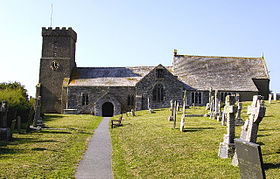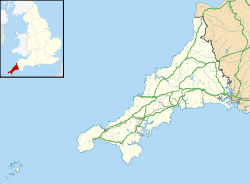- St Carantoc's Church, Crantock
-
St Carantoc's Church, Crantock 
St Carantoc's Church, CrantockLocation in Cornwall Coordinates: 50°24′12″N 5°06′39″W / 50.4032°N 5.1107°W OS grid reference SW 790 605 Location Crantock, Cornwall Country England Denomination Anglican Website St Carantoc, Crantock History Dedication St Carantoc Architecture Status Parish church Functional status Active Heritage designation Grade I Designated 24 October 1951 Architectural type Church Style Norman, Gothic Specifications Materials Slatestone and granite rubble with granite dressings
Slate roofsAdministration Parish Crantock Deanery Pydar Archdeaconry Cornwall Diocese Truro Province Canterbury St Carantoc's Church, Crantock is in the village of Crantock, Cornwall, England. The church has been designated by English Heritage as a Grade I listed building.[1] It is an active Anglican parish church in the diocese of Truro, the archdeaconry of Cornwall and the deanery of Pydar. Its benefice is combined with that of St Cubert.[2]
Contents
History
A church existed on the site before the Norman Conquest and dates back to the time of St Carantoc in the 6th century.[3] The earliest features of the existing church are Norman. A collegiate church was founded on the site by Bishop William Briwere of Exeter in the early 13th century. In 1224 the choir was reconstructed and a tower was added. In 1412 the tower collapsed and was rebuilt.[4] Following the dissolution of the monasteries the college was closed.[5] In the 18th century the roofs and windows were restored. This was followed by a Victorian restoration in the late 19th century and another restoration between 1902 and 1907 by Edmund H. Sedding.[1] When he died in 1921 Sedding was buried in the churchyard.
Architecture
Exterior
The church is built in slatestone and granite rubble with granite dressings and slate roofs. Its plan consists of a west tower, a nave with north and south aisles, north and south transepts, a chancel and a south porch. The tower is in three stages, with each stage being set back and angle buttresses up to the second stage. The parapet is corbelled and embattled. The tower has a west doorway above which is a 19th-century Perpendicular style window. On the south side of the second stage is a clock face. The interior of the church has plastered walls and a slate floor. The arcades contain some Norman architecture. In the west wall of the north transept is a blocked 12th-century doorway.[1]
Interior
In the south aisle is a piscina dating from the 19th century. The font dates from the 12th century. The communion rail dates from the 17th century and the wooden pulpit from the 19th century. The stained glass is from the 19th century although there are fragments of medieval glass in the sacristy.[1] The rood screen dates from 1905 and was carved by Mary Rashleigh Pinwell.[5] The church plate includes a silver chalice dated 1576. The parish registers date from 1559.[4] The ring consists of six bells. Three of these are dated 1767 by John III and Fitzantony II Pennington and the other three were cast in 1904 by John Taylor and Company.[6]
External features
In the churchyard are a number of objects which are listed Grade II. These include a medieval stone coffin,[7] and four monuments.[8][9][10][11] Also in the churchyard are a granite cross dating from the 19th century which is set on a granite base probably dating from before the Norman Conquest,[12] and stocks dating from the 17th century which are set under a 20th-century gabled roof on granite piers.[13] The lychgate at the south entrance to the churchyard dates from the late 19th century.[14]
References
- ^ a b c d "Church of St Carantoc, Crantock", The National Heritage List for England (English Heritage), 2011, http://list.english-heritage.org.uk/resultsingle.aspx?uid=1327391, retrieved 13 May 2011
- ^ St Carantoc, Crantock, Church of England, http://www.achurchnearyou.com/crantock-st-carantoc/, retrieved 18 October 2009
- ^ "Lives of the Cambro British saints", p. 396, 1853, Rev. William Jenkins Rees
- ^ a b Crantock Church, Cornwall, Cornwall Calling, http://www.cornwall-calling.co.uk/churches/crantock-church.htm, retrieved 19 January 2008
- ^ a b Sackett, Eliza (ed.) (2006), British Churches, London: Bounty Books, p. 9, ISBN 0-7537-1442-6
- ^ Crantock S Carantoc, Dove's Guide for Church Bell Ringers, http://dove.cccbr.org.uk/detail.php?searchString=Crantock&Submit=++Go++&DoveID=CRANTOCK, retrieved 13 August 2008
- ^ "Coffin in the churchyard about 7 metres south of south aisle of Church of St Carantoc, Crantock", The National Heritage List for England (English Heritage), 2011, http://list.english-heritage.org.uk/resultsingle.aspx?uid=1137273, retrieved 13 May 2011
- ^ "George monument in the churchyard about 23 metres south of nave of Church of St Carantoc, Crantock", The National Heritage List for England (English Heritage), 2011, http://list.english-heritage.org.uk/resultsingle.aspx?uid=1312396, retrieved 13 May 2011
- ^ "Johns monument in the churchyard about 30 metres southeast of chancel of Church of St Carantoc, Crantock", The National Heritage List for England (English Heritage), 2011, http://list.english-heritage.org.uk/resultsingle.aspx?uid=1144153, retrieved 13 May 2011
- ^ "Martyn monument in the churchyard about 25 metres southeast of chancel of Church of St Carantoc, Crantock", The National Heritage List for England (English Heritage), 2011, http://list.english-heritage.org.uk/resultsingle.aspx?uid=1144154, retrieved 13 May 2011
- ^ "Unidentified monument in the churchyard about 5 metres south of nave of Church of St Carantoc, Crantock", The National Heritage List for England (English Heritage), 2011, http://list.english-heritage.org.uk/resultsingle.aspx?uid=1144152, retrieved 13 May 2011
- ^ "Cross in the churchyard of St Carantoc, Crantock", The National Heritage List for England (English Heritage), 2011, http://list.english-heritage.org.uk/resultsingle.aspx?uid=1327372, retrieved 13 May 2011
- ^ "Stocks in the churchyard about 3 metres north of north transept of St Carantoc, Crantock", The National Heritage List for England (English Heritage), 2011, http://list.english-heritage.org.uk/resultsingle.aspx?uid=1327392, retrieved 13 May 2011
- ^ "Lychgate at the south entrance to the churchyard of St Carantoc, Crantock", The National Heritage List for England (English Heritage), 2011, http://list.english-heritage.org.uk/resultsingle.aspx?uid=1137281, retrieved 13 May 2011
External links
Categories:- Church of England churches in Cornwall
- Grade I listed churches
- Grade I listed buildings in Cornwall
- Norman architecture
Wikimedia Foundation. 2010.

